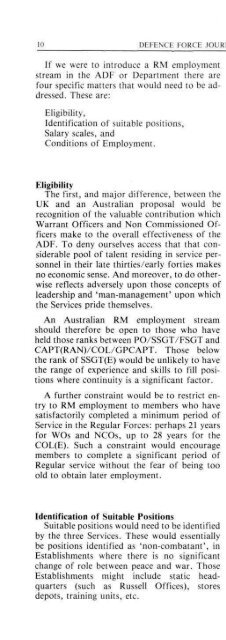ISSUE 75 : Mar/Apr - 1989 - Australian Defence Force Journal
ISSUE 75 : Mar/Apr - 1989 - Australian Defence Force Journal
ISSUE 75 : Mar/Apr - 1989 - Australian Defence Force Journal
- No tags were found...
You also want an ePaper? Increase the reach of your titles
YUMPU automatically turns print PDFs into web optimized ePapers that Google loves.
20 DEFENCE FORCE JOURNAL No. <strong>75</strong> <strong>Mar</strong>ch/<strong>Apr</strong>il 89ed the way in which the physical educationpolicy of many schools has been interpreted. Ageneral policy of non-competitiveness in allsports may have affected the physical quality ofyoung people leaving schools and colleges andpossibly thinking of a military career. Withgovernmental policy graduating towards ageneral reduction in the recruit training programme,training these young people to becomepotential soldiers becomes more intensive,stressful and generally harder for young lowerlimbs to cope with. The high incidents of injuriesrecorded proves a big problem exists.Preventative MeasuresTraining in GeneralOnly thorough training leads to good results,enabling the recruit to build up his muscles,strengthen his joints and bone structure and improvehis co-ordination. Active training willeventually produce the desired performancelevels. It is important that the body parts thatare loaded during training should be given theopportunity to rest and recover. The harder thetraining the longer the break needed for fullrecovery. Exercising repetitively with a heavyload, for example, would require 1-3 daysrecuperation before the next session. Runningand other less strenuous forms of training, onthe other hand, can be practised daily.Daily training, however, after a very longlay-off, or if the individual is physically unfit, isof little benefit and may lead to over use syndromesand/or injuries. Perhaps more anlysisshould take place by Army Chiefs on thedemands placed upon young recruits, and whatis actually required of them in the training process.Apart from the specialised techniquesdemanded of the recruit, there are other factorswhich may influence performances. Those incharge of training should consider the followingquestions:A. What factors influence performance duringtraining?B. Which of these factors can be influenced toimprove training?C. How should the system change to influenceeach of these factors? andD. How much time should be devoted to training,in order to influence each specific factor,which will eventually help the recruit intraining, prevent injury?Is Military Fitness Too High a Standardof Basic Fitness and, if so, Should weDemand it of Our Recruits?Basic Physical FitnessIt goes without saying that good physicalfitness is of the utmost importance in avoidinginjury. Those whose basic fitness is below normalare more prone to injury both from accidentsand from over-use. This becomes moreacute as one gets older. After a period of inactivity,the ability of the body tissues to absorboxygen decreases noticeably. In one experiment,five health test subjects stayed in bed for20-days without any physical activity whatsoever.This relatively short period of inactivityreduced their capacity to absorb oxygen by20-45 per cent. This and similar experimentsdemonstrate how quickly the body adapts tothe physical demands made upon it. When thedemands are reduced there is a correspondingdecrease in the cardiac output, muscle massdecreases (atrophy) and blood volumedecreases. The body is less efficient in transportingoxygen from the lungs to the tissues and, asa result, the energy supply of the muscles isreduced.A basic physical fitness can be achieved byexercises and general physical activity carriedout throughout the year. All training aimed atachieving good basic fitness should be progressive,especially in those not so young. Duringa period of rehabilitation following illness,injury, or a break in training, it is importantthat a reasonable level of basic physical fitnessis reached through remedial programmes,before PTT/BFT or recruit training resumes.Military FitnessMajor Stephen J. Rudzki RAAMC definesMilitary fitness (P28, DFJ Aust No 70May/June 1988) as, "the ability to performmilitary tasks in adverse situations. That is, tofunction effectively and delay fatigue whilstundergoing arduous tasks". He goes on to say,"the context of military environment involvessimultaneous multiple task performance, egwalking, weight carriage, visual scanning andaudio alertness, whilst patrolling". Is it not theresponsibility of our recruit trainingestablishments to provide only the fitness platformon which the above physical demands canbe developed, or are these establishmentsdemanding too much of young civilians in Ar-

















